Middle East (Egypt and Libya) 1939-42
The Egyptian Frontier, 12 June – 12 September 1940
On the outbreak of war on 3 Sep 1939, the 8th Hussars were stationed in Egypt and assigned to the Light Armoured Brigade (Egypt), part of the Mobile Division (Egypt). In Feb 1940 the formations were renamed the 7th Light Armoured Brigade and the 7th Armoured Division which became known as “The Desert Rats” from their formation sign the jerboa or desert rat.
In Apr 1940 the light was dropped from the brigade’s title. In early skirmishing on the Egyptian border with Libya, the 8th Hussars with the 2nd Battalion, Cameron Highlanders made their first real contact with the enemy at Maktila, where there was believed to be an Italian battalion or brigade.
Discover, through the words of Sgt Price, what it was like to experience the ‘Baptism of Fire”.
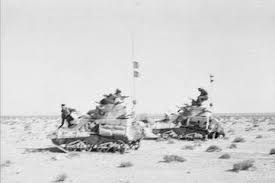
8th Hussars, Western Desert, 1941
When the opposition proved to be an entire division, a quick tactical withdrawal was ordered.
However, the 8th Hussars in the 7th Armoured Brigade continued with a series of victories over the Italian forces in Wavell’s offensive beginning in Dec 1940 with the Battles of Sidi Barrani (8-11 Dec) and Buq Buq (11 Dec).
The rate of vehicle failure was so high that the 8th Hussar had their remaining tanks withdrawn to reinforce other units.
By the time the regiment was re-equipped with Honey tanks, the arrival of the German Afrika Corps had transformed the campaign. Much of 1941 was spent in the desert with the 7th Armoured Brigade, waiting for action.
In Nov 1941, the 8th Hussars now part of the 4th Armoured Brigade in the 7th Armoured Division and the 8th Army, was employed in Operation Crusader, General Auchinleck’s attempt to relieve the besieged garrison in Tobruk.
The 8th Hussars were engaged at the Battle of Sidi Rezegh (19-23 Nov 1941), during which on 19 Nov they were caught in a German counter-attack when the regiment lost 20 tanks.
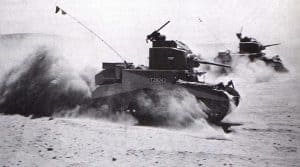
8th Hussars Stuart Tanks 1941
On 21st November, ‘A’ Squadron was wiped out and the Squadron Leader, Major CER Duff, was fatally wounded in a valiant attempt to close with an enemy whose guns effectively out-ranged theirs.
The next day, the 22nd, was disastrous, as their advance toward Sidi Rezegh continued. Fierce fighting went on all day and towards evening the rest of the Regiment, with 4th Brigade HQ, came under concentrated fire from enemy tanks; in spite of being both outnumbered and outgunned they fought desperately until almost completely overwhelmed.
Confused fighting continued that night and the next day only four tanks belonging to the Regiment got away, practically out of petrol, and two others got away with the remnants of the 4th and 7th Armoured Brigades. The survivors pressed on and were involved in the relief of Tobruk (7-10 Dec 1941).
Retreat from Gazala to Alamein Line, 26 May – 27 Jul 1942
On 26th May 1942 Rommel and the Afrika Korps started to move back eastwards again and, taking a route avoiding Bir Hacheim, ran straight into the Regiment, who, as part of 7th Armoured Division, was holding the southern end of the British line which stretched to Gazala on the coast.
In the savage fighting that followed the Regiment, outnumbered and still outgunned despite now having some ‘General Grant’ tanks, was almost destroyed again and suffered many casualties, chiefly in ‘A’ Squadron who lost all their officers.
A German attack of over 100 tanks on the night of 26/27 May fell heavily on the regiment’s position. The fighting lasted some 15 minutes, by which time all but two of the 8th Hussar’s tanks had been hit and put out of action.
Although the regiment was temporarily finished as an operational unit, the survivors with some new tanks formed a composite squadron with the remnants of the 3rd Royal Tank Regiment that was engaged at Mersa Matruh in late Jun.
Later a composite 4th/8th Hussars unit was organised that fought at the Battles of Alam el Halfa (30 Aug 7 Sep) and El Alamein (23 Oct – 4 Nov 1942).
Lt Col C Goulburn took command of the Regiment in June 1942 and promptly reorganised them into an RHQ and two Squadrons, one of which ‘C’ under Maj Hackett, was placed under command of the 4th Hussars in July, forming a Composite Regiment, the 4th/8th Hussars.
Alam El Halfa, 30 August – 7 September 1942
The 4th/8th Hussars played an interesting and vital role in this battle that proved to be a turning point for the whole war, as Rommel’s final desperate bid to reach Cairo and the Suez Canal was beaten back.
The 7th Armoured Division initially faced his full assault but as planned fell back before it, when the German thrust swung north to the Alam el Halfa Ridge. The 4th/8th’s task was to move along the Qattara Depression and suddenly appear in the rear of the German forces which they did with complete success, falling upon the enemy’s vulnerable rear echelons and destroying over 50 vehicles.
El Alamein, 23 October – 4 November 1942
Throughout the battle of Alamein, ‘A’ Squadron stayed with the 4th/8th Hussars in the 4th Light Armoured Brigade. The main task was to penetrate the two big minefields which shielded the main enemy positions. ‘A’ Squadron had the task of clearing anti-tank resistance to the east of these and giving protection to the formations waiting to go through.
By the time that happened they had lost five tanks on mines and several by gunfire before, on 3rd November, the last anti-tank screen had been forced back and Rommel’s forces were in full retreat.
For ‘A’ Squadron the pursuit which followed westwards through Libya lasted three weeks. Enemy action, random mines and mechanical action failures gradually reduced the Squadron’s tanks.
By 24th November they had reached el Magrun, west of Benghazi, and with no replacement tanks, ‘A’ Squadron was given orders to call off the chase and return to RHQ at Sidi Bishr, 700 miles behind them.
With the ending of operations in North Africa, the 8th Hussars was to Cyprus to reorganise after its heavy losses and then sent home to re-equip as an armoured reconnaissance regiment and retrain.
The Pause
Together for the first time since May 1942, the Regiment spent six months of rest and reinforcement in Cyprus. A few months in Cyrenaica followed until they finally sailed for England in November 1943 and nearly ten years to the day since it had left for Egypt the Regiment came home.
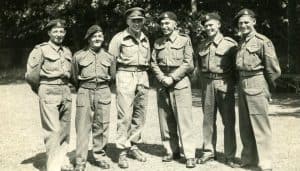
8th King’s Royal Irish Hussars prior to the Invasion of Normandy.
The whole of the 7th Armoured Division was now concentrated in Norfolk, with the Regiment as its Armoured Reconnaissance Regiment with the role of close tactical reconnaissance between the Armoured Car Regiment, the 11th Hussars and the Division.
For this task, they were equipped with ‘Cromwell’ tanks throughout RHQ and the sabre squadrons, as well as light tanks and scout cars in the Reconnaissance Troop.
For four months at West Tofts Camp they trained, were inspected frequently and entertained as much as rationing would allow.
From West Tofts the Regiment moved to Bognor Regis to waterproof the tanks and test them in the sea in preparation for the invasion ahead of them.
North-West Europe 1944-45
On D-Day, June 6th, they watched from their marshalling area the Airborne troops go over and at one o’clock in the morning of June 9th the convoy carrying the Regiment, less ‘C’ Squadron, moved out to sea and by 7 pm were all safely ashore at Le Hamel.
Normandy, June – August 1944
No contrast could have been greater than between the open deserts they had so recently left and the close ‘bocage’ country in which the Regiment now found itself. From the air, it looked like continuous woodland but it was, in reality, small fields surrounded by high-backed hedges of pollard-ed trees, orchards and a network of narrow tracks so overhung with hedgerow growth that they were almost tunnels.
To these natural defences, the Germans had added two weapons of their own, the ‘Tiger’ and ‘Panther’ tanks, both heavier armed and more heavily armoured than our ‘Shermans’ and ‘Cromwells’ and which, though less manoeuvrable, were well-suited for the defensive fighting ahead.
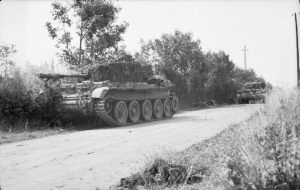
8th King’s Royal Irish Hussars in the Villers Bocage area of Normandy, June 1944
7th Armoured Division’s push to Villers Bocage in mid-June had left a large bulge in the line due to the slow progress of their flanks and thus they were subjected to repeated, though unsuccessful, heavy enemy counter-attacks.
The flanking divisions couldn’t stabilise the line so the Division had to withdraw, with the Regiment as the rearguard and ‘B’ Squadron literally the last out of the pocket.
For a desperate fortnight at the beginning of August, the Regiment was involved in ‘Operation Bluecoat’ an attempt to remove or bypass the Germans dug in on Mont Pincon and link up with the American breakout of the Cherbourg Peninsula.
Between 17-20 August, the Regiment spearheaded their Division’s crossings of the River Dives and River Vie, reinforcing the bridgehead.
Why not discover more about the movements of the Regiment through extracts taken from a diary kept by Lt Col C. Goulburn then commanding the 8th Hussars.
Nederrijn, 17-27 September 1944
Although the port of Antwerp was in Allied hands it could not be used as long as the Germans dominated its approaches. At first, the Regiment and 7th Armoured Division operated in the vicinity of Antwerp itself but when the airborne attacks on Eindhoven, Nijmegen and Arnhem were made they moved into Holland through Eindhoven to St Oodenrode.
The airborne operation ‘Market Garden’ proved too ambitious, and with the failure of the 21st Army Group to relieve the besieged forces of Arnhem, the chance of crossing the Rhine in 1944 was lost.
The task of clearing the Germans from Holland continued and the Regiment suffered more casualties. Finally, after many small fierce engagements during October and November, the country through s’Hertogenbosch and Pilburg along the south bank of the Maas was cleared of the enemy and the Port of Antwerp could, at last, be used.
The Roer, 20-21 January 1945
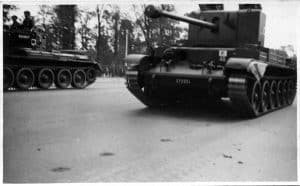
Challenger Tank Destroyer, B Squadron
The German offensive through the Ardennes was designed to reach Antwerp and divide the US 1st Army from the British 2nd Army, which had started on 16th December and caused some disruption to the Allied plans before it was overcome.
In early 1945 during Operation ‘Blackcock’, to clear the country to the River Roer, the Regiment found themselves in a fierce battle for the village of St Joost.
In company with the Motor battalion, field guns, flame-throwing Crocodiles and an Infantry Brigade which accepted many casualties, it took two days to clear, losing several tanks in the process.
A few days later the small town of Linne was liberated following a unique charge across snow-covered fields by ‘C’ Squadron, commanded by Major Huth, carrying 10 Commandos on the back of each tank. By 26th January the whole area to the Roer had been cleared.
For some weeks there followed an un-warlike calm. Back in Maeseyck for the second time and issue, one per troop, with a new tank the Challenger, carrying a 17pdr gun, the Regiment rested, re-organised and fired their new equipment on ranges nearby.
Rhine, 1945
Meanwhile, the 1st Canadian Army came down from the north, the 9th American Army worked up from the south and at the last moment arrived for operation ‘Plunder’, the push across the Rhine to begin. The Regiment watched the Airborne divisions flying over to create the bridgehead and on the 27th of March at 11 pm crossed on the Bailey bridge at Xanten.
A week later after 120 miles, scarcely one of which was unopposed, the Regiment reached the river, Ems. Ibbenburen, home of the Hannover Cadet School, together with the Tecklenburg Hills, was stubbornly defended by ardent young Nazis and was not taken until 7th April, as the 7th Armoured Division fought its way to the River Weser.
Crossing the River Weser at Nienburg on 13th April and the River Aller at Rethem two days later the route to Hamburg was open.
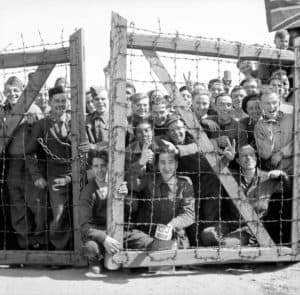
POWs at Stalag X1B at Fallingbostel in Germany welcome their liberators, 16 April 1945.
One dramatic event which gained nationwide publicity was the discovery and liberation of prisoner of war camp Stalag X1 B at Fallingbostel by the Reconnaissance Troop on 16th April.
The camp held 6500 British and Americans, some of whom had been prisoners for five years, (as well as 8000 assorted Allied nationals) and their release, together with those from nearby Stalag 357, provoked joy throughout Britain.
Actions followed and more casualties were sustained at Heber and at Hollenstedt.
Finally at the three villages of Wulmstorf, Daerstorf and Elstorf, tactically important as they overlooked Hamburg and the Elbe, the final shots of the long campaign were fired and Lt WF Ryde was killed, the last 8th Hussar to lose his life in the field.
After passing through Hamburg the Regiment crossed the Kiel canal and spent VE day in Schleswig Holstein, where for several weeks they dealt with the aftermath of war.
After the victory parade in Berlin, the 8th Hussars remained as part of the British Army of the Rhine. In Aug 1945 the Regiment was still in Germany and part of the 7th Armoured Division till its return to Leicester in 1948.
Battle Honours
The 8th King’s Royal Irish Hussars were awarded a total of 20 battle honours during this period.
Why not discover the story behind each one:
- Egyptian Frontier 1940
- Sidi Barrani
- Buq Buq
- Sidi Rezegh 1941
- Relief of Tobruk
- Gazala
- Bir El Igela
- Mersa Matruh
- Alam El Halfa
- El Alamein
- North Africa 1940-42
- Villers Bocage
- Mont Pincon
- Dives Crossing
- Nederrijn
- Best
- Lower Mass
- Roer
- Rhine
- North West Europe 1944-45
Campaign Medals
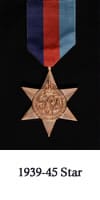
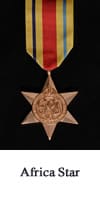
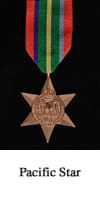
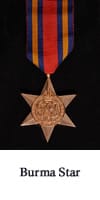
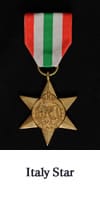
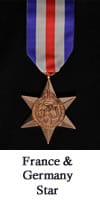

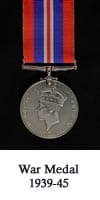
A series of various stars were issued for the campaigns of World War 2. The colours of the ribbons have symbolic significance and are believed to have been designed personally by King George VI.
No more than 5 stars may be awarded to one person. Those who qualify for more are awarded a clasp with the title of one of the stars to which they qualify. The clasp is then attached to the ribbon of one of the other stars.
1939 to 1945 Star. The 1939 to 1945 Star was awarded to personnel who completed operational service overseas between 3 September 1939 and 8 May 1945 (2 Sept 1945 in the Far East).
Africa Star. The Africa Star was awarded to personnel who served in North Africa, Malta or Egypt between 10 June 1940 and 12 May 1943.
Pacific Star: Malaya, Singapore and the Pacific Ocean. The Pacific Star was awarded for operational service in Malaya, Singapore, China, Hong Kong or Sumatra between 8 December 1941 and 2 September 1945.
Burma Star. The Burma Star was awarded for operational service in Burma between 11 December 1941 and 2 September 1945. Those serving in Bengal and Assam in India and China, Hong Kong, Malaya or Sumatra between other specified dates may also qualify.
Italy Star. The Italy Star was awarded for operational service in Sicily or Italy between 11 July 1943 and 8 May 1945. Those who served in Yugoslavia, Greece, Corsica or Sardinia between certain other specified dates would also qualify.
France and Germany Star. The France and Germany Star was awarded for operational service in France, Belgium, Luxembourg, The Netherlands or Germany between 6 June 1944 and 8 May 1945.
The Defence Medal. The Defence Medal is awarded for non-operational services such as those service personnel working in headquarters, on training bases and airfields and members of the Home guard.
War Medal 1939 to 1945. The War Medal was awarded to all full-time personnel of the armed forces wherever they were serving. The medal was granted in addition to campaign stars and the Defence Medal.

